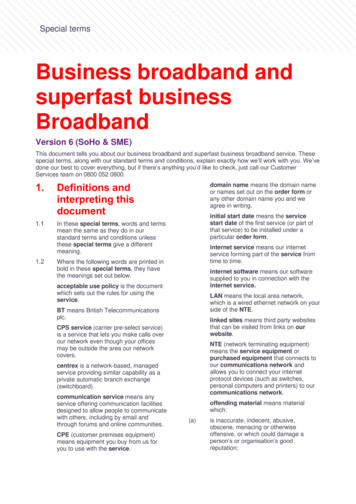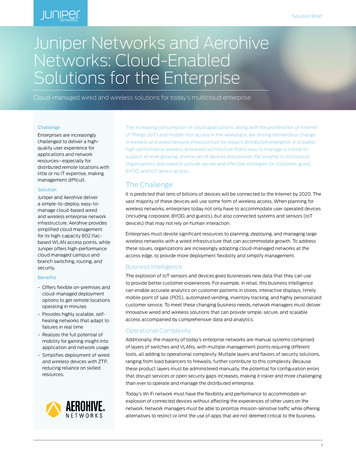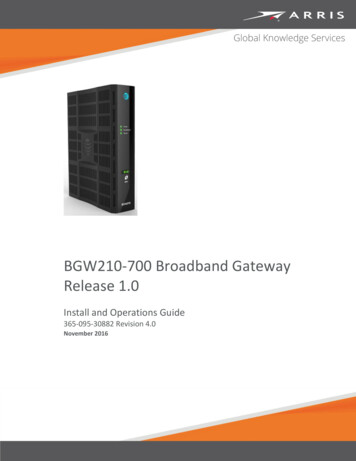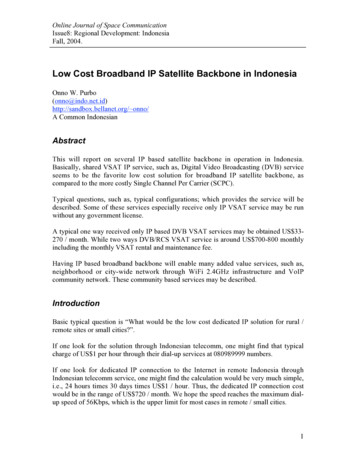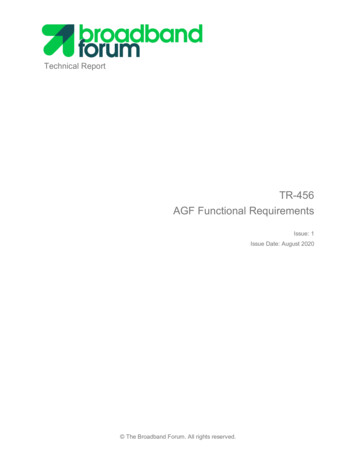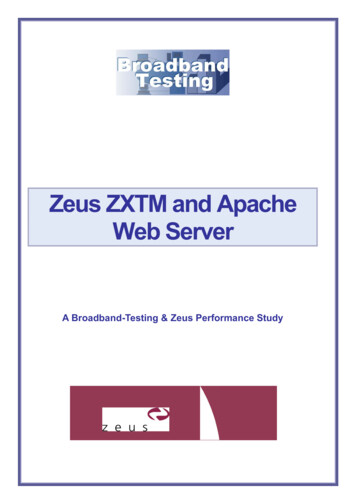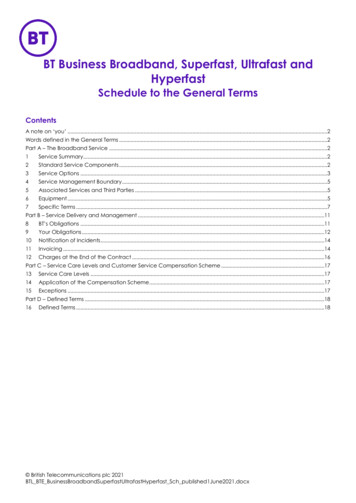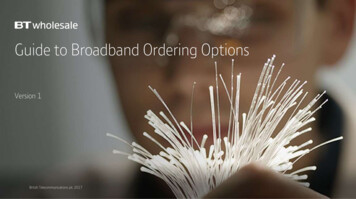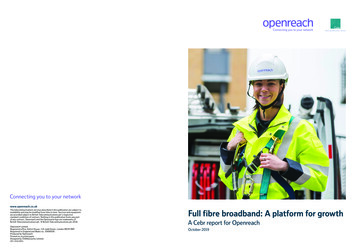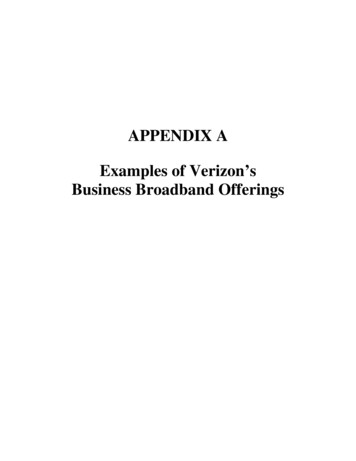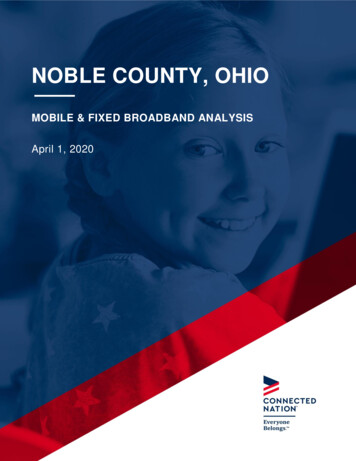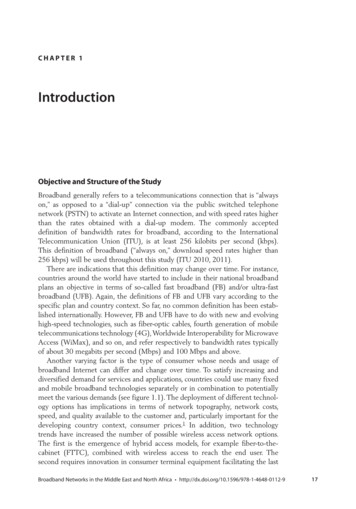
Transcription
Chapter 1IntroductionObjective and Structure of the StudyBroadband generally refers to a telecommunications connection that is “alwayson,” as opposed to a “dial-up” connection via the public switched telephone network (PSTN) to activate an Internet connection, and with speed rates higherthan the rates obtained with a dial-up modem. The commonly accepteddefinition of bandwidth rates for broadband, according to the International Telecommunication Union (ITU), is at least 256 kilobits per second (kbps).This definition of broadband (“always on,” download speed rates higher than256 kbps) will be used throughout this study (ITU 2010, 2011).There are indications that this definition may change over time. For instance,countries around the world have started to include in their national broadbandplans an objective in terms of so-called fast broadband (FB) and/or ultra-fastbroadband (UFB). Again, the definitions of FB and UFB vary according to thespecific plan and country context. So far, no common definition has been established internationally. However, FB and UFB have to do with new and evolvinghigh-speed technologies, such as fiber-optic cables, fourth generation of mobiletelecommunications technology (4G), Worldwide Interoperability for MicrowaveAccess (WiMax), and so on, and refer respectively to bandwidth rates typicallyof about 30 megabits per second (Mbps) and 100 Mbps and above.Another varying factor is the type of consumer whose needs and usage ofbroadband Internet can differ and change over time. To satisfy increasing anddiversified demand for services and applications, countries could use many fixedand mobile broadband technologies separately or in combination to potentiallymeet the various demands (see figure 1.1). The deployment of different technology options has implications in terms of network topography, network costs,speed, and quality available to the customer and, particularly important for thedeveloping country context, consumer prices.1 In addition, two technologytrends have increased the number of possible wireless access network options.The first is the emergence of hybrid access models, for example fiber-to-thecabinet (FTTC), combined with wireless access to reach the end user. The second requires innovation in consumer terminal equipment facilitating the lastBroadband Networks in the Middle East and North Africa http://dx.doi.org/10.1596/978-1-4648-0112-917
18IntroductionFigure 1.1 Broadband Consumer Needs and Technology OptionsBandwidth and time required per activity1 Mbps10 Mbps30 Mbps100 MbpsGraphical websites0.0014 sec 1 sec 1 sec 1 secMusic track0.0140 sec4 sec1 sec 1 secMusic album0.1013 min1 min27 sec8 sec250 photo2.004.5 h27 min9 min2.5 minDVD movie4.5010 h1h4.506 min1h of personal HD video1227 h2.5 h53 min16 minHD movie252.5 days4.5 h1.5 h27 minFull online backup15014 days1.5 days11 h3.5 hMost commontechnological choicesNOT acceptablequalityMobileSize, Gb3G(UMTS)FixedEnd user’s activitiesADSL3.5 GVDSL4G(LTE)FTTC4G (LTE advanced)FTTBFTTHSource: Based on Booz & Company, February 2012.Note: 3G third generation of mobile telecommunications technology; 4G fourth generation of mobile telecommunications technology;ADSL asymmetric digital subscriber line; DVD digital video disk; FTTB fiber-to-the-building; FTTC fiber-to-the-cabinet, fiber-to-the-curb;FTTH fiber-to-the-home; Gb gigabit; h hour; HD high definition; LTE long-term evolution; Mbps megabits per second; min minute;sec second; UMTS Universal Mobile Telecommunications System; VDSL very-high-bit-rate digital subscriber line.mile connection. Broadband, through Wireless local area network productsIEEE802.11 standards (Wi-Fi) or third generation of mobile telecommunicationstechnology (3G) for example, can be made available through mobile phones,laptops, tablets, and other devices.Most countries in the Middle East and North Africa (MENA) have identifiedbroadband as a critical input to broader efforts in nation building and thetransition to a knowledge-based economy. There is growing consensus that broadband Internet is a prerequisite for a modern economy and fosters sustainable economic development and job creation. Furthermore, it is strategicto the goals of enhancing job opportunities and reducing poverty in the region.The objective of this study is to assess the status of development of broadbandin MENA, to identify key bottlenecks to broadband expansion, and to offersuggestions on how to accelerate investment and diffusion of broadband connectivity through supply-side measures. The focus of this study is thereforeon infrastructure-related actions, and measures to stimulate demand of broadband will therefore only be touched upon.2Broadband Networks in the Middle East and North Africa http://dx.doi.org/10.1596/978-1-4648-0112-9
IntroductionMap 1.1 Economies in the MENA RegionSource: World Bank.For the purpose of this report, the MENA region comprises 19 countries,grouped in four subregional clusters (see map 1.1): Five North African economies: Algeria, the Arab Republic of Egypt, Libya, andTunisia; Six Mashreq economies: the Islamic Republic of Iran, Iraq, Jordan, Lebanon,the Syrian Arab Republic, and the West Bank and Gaza; Six Gulf economies: Bahrain, Kuwait, Oman, Qatar, Saudi Arabia, and theUnited Arab Emirates; and Djibouti and the Republic of Yemen.The rest of this report is organized as follows. Chapter 1 presents the importance of broadband for economic and social development for MENA aswell as how MENA compares internationally in terms of broadband. Chapter 2examines in more detail the current state of broadband networks and constraining factors for broadband development. In chapter 3, the key challenges ofbroadband infrastructure deployment and development of competition in MENA countries are identified. Chapter 4 provides recommendations on whatcould be done to further accelerate the development of broadband infrastructure. Finally, case studies of the status of broadband policy and broadbanddevelopment in selected MENA countries (Algeria, Egypt, Jordan, Libya, Morocco, and Tunisia) are presented in the appendix.Broadband Networks in the Middle East and North Africa http://dx.doi.org/10.1596/978-1-4648-0112-919
20IntroductionWhy Is Broadband Important for Economic and Social Development?There is growing consensus that broadband is an essential general purposetechnology (GPT) that has pervasive productivity impact on multiple sectors ofthe economy (e.g., energy, water, industrial production, services, transport, and soon). Broadband has a similar impact on the transformation of the economy asprevious GPTs had in the past, including the printing press, steam engines, andelectricity. The Organisation for Economic Co-operation and Development(OECD) defines broadband as a GPT that, in combination with other technologies, can have a deeply rooted impact on economic activity (OECD2008, 5–6). Broadband is today a powerful driver for sustainable economicgrowth,3 job creation, and human skills development as well as, more generally,an enabler of democracy and social transformation.Sustainable Economic GrowthBroadband infrastructure and services contribute directly to a country’s productivity, competitiveness, and ability to attract foreign direct investment (FDI).Broadband can help countries in the region to diversify away from naturalresource related sectors. This is particularly strategic for a region characterizedby exports of primary commodities, mainly oil and gas, accounting for 76 percentof total exports during the period 2008–10.Further, Thompson, Jr, and Garbacz (2008) indicate that availability of broadband services may have indirect benefits on economies, such as reducinginefficiency and improving productivity of other inputs. In a later study, theseauthors have shown that increased access to fixed broadband and mobile broadband in particular has greater impact on poorer countries. Nabli (2007) estimatesthat the share of MENA non-oil manufacturing exports as a percentage of worldtrade has fallen steadily since the 1960s, and is quite small compared to otherregions of the world. He finds that a group of five Eastern European countries—the Czech Republic, Hungary, Poland, the Russian Federation, and Turkey, witha population similar to MENA’s (about 270 million)—had non-oil exports fivetimes higher than MENA’s. Similarly, Indonesia, Malaysia, and Thailand hadnon-oil exports seven times bigger than MENA’s. Four Latin American countries—Bolivia, Brazil, Chile, Mexico, and Brazil—had non-oil exports eighttimes greater than MENA’s. MENA’s exports–to–gross domestic product (GDP)ratio is about one-third of its potential, even though there has been some growthin recent years (Behar and Freund 2011). By contrast, Asian economies haveprogressively increased their global market shares, through the advancements inbroadband infrastructure and other strengths in high-tech sectors, in conjunctionwith appropriate trade policy reforms.Access to affordable and quality broadband service reduces transaction costsand allows flexible firm locations.4 Countries in MENA have the ambition to beincreasingly integrated with regional and global manufacturing and there is initialevidence that some of the countries have real potential to move up the valuechain of global manufacturing (Diop and Ghali 2013). In addition, broadbandallows for information technology (IT)-enabled service exports such as businessBroadband Networks in the Middle East and North Africa http://dx.doi.org/10.1596/978-1-4648-0112-9
21Introductionprocess outsourcing (BPO). Egypt was ranked the fourth most important destination for BPO by A.T. Kearney (2011). Other countries in the region have alsosuccessfully entered the global scene for BPO. As for global manufacturing, innovation in BPO is increasingly driven by IT, enabled by broadband.5 A study of 27developed and 66 developing countries found that a one percentage pointincrease in the number of Internet users is correlated with a boost in exports of4.3 percentage points (Clarke and Wallsten 2006). Broadband also contributes tothe competitiveness of the service sector, bringing positive spillover effects to lesstechnology-intensive industries. The availability of high-speed, reliable, and reasonably priced Internet access is a key determinant in FDI decisions.6Job Creation and Human Skills DevelopmentAs witnessed in both developed and developing countries, broadband can be a keyenabler of job creation (see table 1.1). Katz (2009) estimated that the implementation of the broadband plan in Germany would create one million jobs over thenext 10 years and contribute substantially to Germany’s GDP.7 In the UnitedStates, it is estimated that broadband added 1.0–1.4 percentage points to thegrowth rate in the number of jobs during 1998 and 2002. Broadband helps allocate activities more efficiently between workers tackling complex, highly dynamictasks and more traditional workers (Kim, Kelly, and Raja 2010). Broadband alsoexpands the frontiers of traditional jobs, enabling new job and income opportunities, including information and communications technology (ICT)-based contracting, microwork and crowdsourcing, jobs in the virtual economy, and jobsrelated to the emerging app economy (Rossotto, Kuek, and Paradi-Guilford2012). This is particularly pertinent to the MENA region, which is characterizedby high unemployment, including among youth, women, and graduates.Broadband is also important for human skills development. Qiang andRossotto (2009) point out the following:Individuals can acquire skills (increasing their marketability as workers) and developsocial networks through broadband-enabled Web applications, facilitating peer-to-peercommunities and their integration with the economy. Blogs (online diaries), wikis (Websites where users can contribute and edit content), and the like have created new, decentralized, dynamic approaches for capturing and disseminating the knowledge neededfor individuals to become better prepared for the knowledge economy. Furthermore, broadband can enhance a city’s or a country’s appeal to the “creative class” of knowledge workers and attract human capital amid intensifying global competition for talented workers.Table 1.1 Examples of Broadband Employment MultipliersStudyCrandall (2003)Katz and Suter (2009)Atkinson (2009)Katz (2009)CountryDirectIndirectInducedTotalUnited StatesSwitzerlandUnited StatesUnited 63.42Source: Adapted from Katz 2009.Broadband Networks in the Middle East and North Africa http://dx.doi.org/10.1596/978-1-4648-0112-9
22IntroductionFigure 1.2 Percentage of Wikipedia Articles per LanguageArabic,1.34Other an,4.70English,32.15Source: Wikipedia (http://meta.wikimedia.org/wiki/List of Wikipedias, accessedSeptember 2013).In addition, the digital content of languages is a primary source for knowledgeto build a community capable of competing in the fields of science and technology on the global stage. Arabic digital content amounts to just 0.162 percent ofthe total digital content available online.8 In addition to this international language gap, even inside the MENA region itself only 42 percent of all webpagesare published in Arabic (Kelly and Rossotto 2012). Moreover, the number ofwebsites hosted in the MENA region amounts to only 0.198 percent of theglobal total. To draw an even clearer picture, figure 1.2 indicates that only1.34 percent of articles published in Wikipedia are in Arabic. This directlyrestricts access for a large number of individuals in the MENA region and limitstheir ability for online learning and knowledge sharing.Broadband also enables “smart” infrastructure, including smart electricity gridsand smart meters, and intelligent transport systems. Liebenau et al. (2009) identified broadband, smart electricity grids, and intelligent transport systemsas the three key technological advances in infrastructure that would have the highest impact on job creation in the UK economy. According to Covassi deEncarnacao (2013), the 2010 Digital Agenda for Europe combines a boldapproach for high-speed broadband deployment with a firm commitment togreen ICT using ICT to increase energy efficiency. Broadband enables integratedmachine-to-machine (M2M) platforms for cost optimization and smart grid andsmart meter infrastructure. This infrastructure can greatly enhance the performance of the electricity grid, reduce peak load energy requirements, allow forbetter integration of renewable energy sources, and promote effective energy use(Nocentini, Gavazzi, and Pupillo 2013). Moreover, broadband enables big dataBroadband Networks in the Middle East and North Africa http://dx.doi.org/10.1596/978-1-4648-0112-9
Introductionanalytics for better traffic management systems and electricity use (Nocentini,Gavazzi, and Pupillo 2013). These applications are of strategic importance givenMENA’s focus on renewable energy generation and the need to better managethe electricity demand of industrial users. Broadband can be a powerful tool totackle the climate change agenda in MENA.Democracy and Social TransformationFinally, broadband is an enabler of democracy and social transformation, as witnessed by the powerful role played by new and social media networking during the Arab Spring. Despite being a latecomer in the introduction of Internetservices, the effects of enhanced connectivity in the Middle East have alreadytransformed societies in the region to a large extent. With the recent uprisingstaking place in a number of countries, the Internet has played a key role inadvancing social inclusion, accountability, human rights, and civil engagement.However, social media is not only a domain for the liberal youth. It alsoempowers different agendas across the civil society map. Three of the top fivemost followed Arab personalities on Twitter are religious preachers (MRD2012). In this respect, the diffusion of the Internet in the Middle East andenhanced connectivity has created a virtual space in which young people areinteracting on a variety of issue areas spanning a wide range of topics. Withincreased content in the Arabic language, broadband Internet could play animportant role in preserving the cultures of the region.Social networking tools have the potential to enhance citizen engagement inthe region, promote social inclusion, and create opportunities for employment,entrepreneurial activities, and social development. However, the penetration ofsocial networking in the MENA region, although rapidly growing, is still low incomparison to other regions in the world. Governments in the MENA region arefaced with a historic opportunity to leverage social media to better advance various development agendas for their increasingly youthful societies. According toa white paper released by the Dubai School of Government and the online job-hunting site Bayt.com, 71 percent of Arabs use the Internet as an alternativeto traditional communication (Alshaer and Salem 2013). Young people between15 and 29 years of age make up 75 percent of Facebook users (Dubai School ofGovernment 2011) in the Arab region that total 46,422,540, in addition to2.17 million Twitter users, 80 percent of whom spend more than an hour eachday updating their social networking channel.9How Does MENA Compare in Terms of Broadband?Looking again at the 11 countries considered by Nabli (2007) in the sectionabove as an example of good trade performance compared to the countriesin MENA, both low price of international communications and higher b roadbandpenetration seem to have enabled their good performance, in conjunctionwith appropriate trade policy reforms (see table 1.2). The average price of international communications in the sample of countries with strong exportBroadband Networks in the Middle East and North Africa http://dx.doi.org/10.1596/978-1-4648-0112-923
24IntroductionTable 1.2 Overview of Broadband in MENAEconomyRussian FederationTurkeyHungaryCzech aysiaThailandSimple Average, Countries in Nabli (2007)Weighted Average Countries in Nabli(2007)SkypeOut rate(USc/min)Fixed broadbandpenetration (% ofhouseholds)Mobile broadbandpenetration (3G 4G)(% of aLibyaEgypt, Arab Rep.LebanonSyrian Arab RepublicWest Bank and GazaJordanIran, Islamic Rep.IraqOmanSaudi ArabiaYemen, Rep.DjiboutiBahrainUnited Arab 67.78MENA, Simple AverageMENA, Weighted 0.91.327.891.872.82Sources: Skype, http://www.skype.com; World Bank analysis based on data from TeleGeography’s GlobalComms Database http://www . telegeography.com, December 2012, data retrieved August 2013.Note: 3G third generation of mobile communications technology; 4G fourth generation of mobile communications technology;MENA Middle East and North Africa; USc/min US cents per minute.Broadband Networks in the Middle East and North Africa http://dx.doi.org/10.1596/978-1-4648-0112-9
Introductionperformance outside of MENA is about one-sixth of the average price of international communications in MENA, as measured by average SkypeOut rates.10Two countries in the same geographic region illus
broadband as a critical input to broader efforts in nation building and the transition to a knowledge-based economyThere is growing consensus that . broadband Internet is a prerequisite for a modern economy and fosters sustainable economic d
